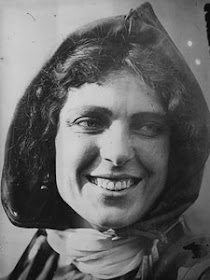So Lt. Thomas Selfridge was the passenger when the Wright biplane crashed to earth (above). Selfridge was killed on impact. Charlie was the first to reach the crash. He pulled the injured Orville out of the wreckage and then, after the doctors had taken his friend and boss away, it was Charlie who broke down sobbing. But it was also in Charlie’s character that he tore the wreckage apart until he found out exactly what had caused the crash. He was a painfully shy mechanical genius, the man who maintained the “Vin Fiz Flyer” most of the way across the continent. Without Charlie Taylor there would have been no transcontinental flight, and no Wright Brothers either - and they all knew it.
Charlie went to work for the brothers in 1901 at $18 for a sixty hour week in their bicycle shop (above), and he stayed because their personalities fit so well together. Explained Charlie, “The Wrights didn’t drink or smoke, but they never objected too much to my cigar smoking….Both the boys had tempers, but no matter how angry they ever got I never heard them use a profane word…(and) I never let go with anything stronger than heckety-hoo.”
Charlie and the brothers sketched out the world’s first wind tunnel on scrap pieces of paper, and then Charlie built it (above). Without that testing device, powered flight would have had to wait for accidental discovery. What the Wright Brothers and Charlie achieved was not just powered flight, but the scientific approach to powered flight, prediction and experimentation, proving powered flight before it had even been made. And that made improvements possible and predictable. After letters to automobile manufactures failed to find a suitable engine, Charlie built the first aircraft motor (and only the second gasoline engine he had ever built) from scratch, in just six weeks, using only a drill press, a metal lathe and some hand tools. At every step of the Wright Brothers innovations, Charlie Taylor was vital to the process.
In 1911 Cal Rogers approached Charlie and offered him $70 a week - plus expenses - to travel with the “Vin Fiz Flyer” across country and keep it in the air (above, Charlie and Cal, repairing the Flyer.). “At the time my wages were $25 a week," explained Charley. "I told him I'd go; then I told ‘Orv ‘about it. He asked me not to quit. I told him I had already given my word to Rodgers and couldn't very well back out. He told me to make it a sort of leave of absence, and to be sure and come back.” And that was how Charlie began what he later called “…my adventures”.
Charlie never had any doubt Cal would make it. He sent his wife and three children ahead to California to await his arrival. But Charlie was no diarist. He left behind no impressions of what it was like to be cooped up with Mable Rogers and Maria (Rogers) Swietzer for all those days and nights. But I am not surprised that Charlie quit not long before matters came to a head between Lucy Belevedere and Mable. I imagine the drama and the emotion made Charlie very uncomfortable. He jumped the train in Texas and hurried on to meet his family in Los Angles because his wife had become ill.. He took his wages from the trip and bought several hundred acres along the Salton Sea. But it was almost a year before his wife was feeling well enough to return to his job in Ohio.But things had changed. While he had been away, in May of 1912, Wilbur had died of typhoid fever. Orville made sure Charlie had a job, but, according to Charlie, “I found it wasn’t like old times….the pioneering days seemed over for me.” Finally, in 1919, Charlie left the Wright Company and returned to California. He opened his own machine shop on his property on the Salton Sea. “I waited for something to happen there,” Charlie said later, “and nothing did.” Except that his wife died and the depression of the 1930's drove him out of business, and he lost his land.
Charlie moved to Los Angeles and found a job working for North American Aviation for 37 cents an hour. He told no one about his past. He was just another production line mechanic. None of his fellow workers knew that he had helped to invent the entire industry. And that was where Henry Ford found him.
Ford was rebuilding the Wright Brothers workshop in Dayton as a memorial, and had hired detectives to track Charlie down. Ford brought Charlie back to reconstruct the wind tunnel and put the original 1903 Flyer back together. In 1941, his work for Ford finished, Charlie quietly went back to California and returned to work in a defense plant. Then in 1945, Charlie suffered a heart attack. He was never able to work again. When Orville Wright died in 1948 he left Charlie an annuity in his will of $800 a year. By 1955 inflation had reduced that to a pittance, and when a newspaper reporter found Charlie, he was surviving in the charity ward of a Los Angles hospital. Immediately the aviation community raised funds, and Charlie was able to spend his last months in a private hospital, under far better care.
He died at the age of 88 in 1956. He is buried in the Folded Wings Mausoleum, in Valhalla Memorial Park (above), directly under the approach to Burbank Airport runway 15-33.
Charlie Taylor lived for 48 years after he gave up his seat to a young Army Lieutenant. And he never did learn to fly. And that too was typical for Charlie Taylor, the unsung hero of powered flight.
- 30 -






























































